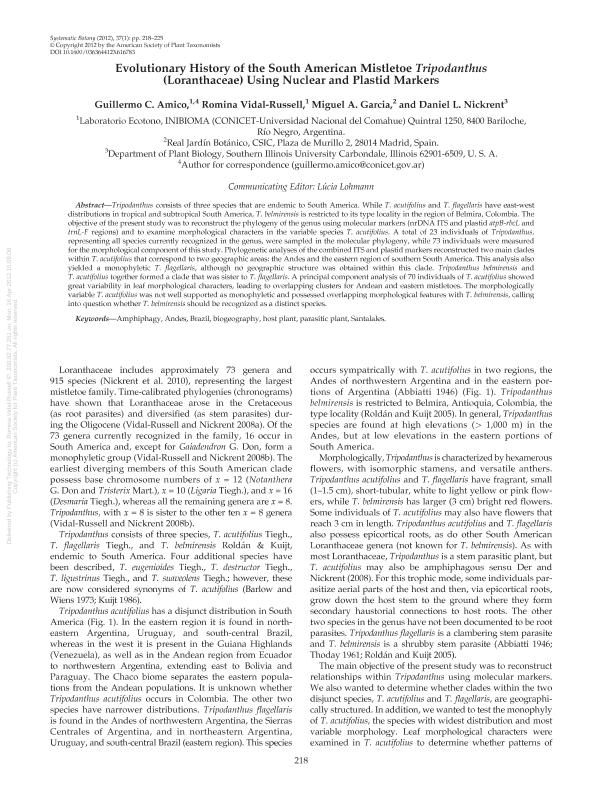Artículo
Evolutionary History of the South American Mistletoe Tripodanthus (Loranthaceae) using Nuclear and Plastid Markers
Fecha de publicación:
01/01/2012
Editorial:
American Society of Plant Taxonomists
Revista:
Systematic Botany
ISSN:
0363-6445
Idioma:
Inglés
Tipo de recurso:
Artículo publicado
Clasificación temática:
Resumen
Tripodanthus consists of three species that are endemic to South America. While T. acutifolius and T. flagellaris have East-West distributions in tropical and subtropical South America, T. belmirensis is restricted to its type locality in the region of Belmira, Colombia. The objective of the present study was to reconstruct the phylogeny of the genus using molecular markers (nuclear ribosomal ITS and plastid atpB-rbcL and trnL-F regions) and to examine morphological characters in the variable species T. acutifolius. A total of 23 individuals of Tripodanthus, representing all species currently recognized in the genus, were sampled in the molecular phylogeny, while 73 individuals were measured for the morphological component of this study. Phylogenetic analyses of the combined ITS and plastid markers reconstructed two main clades within T. acutifolius that correspond to two geographic areas: the Andes and the eastern region of southern South America. This analysis also yielded a monophyletic T. flagellaris, although no geographic structure was obtained within this clade. Tripodanthus belmirensis and T. acutifolius together formed a clade that was sister to T. flagellaris. A principal component analysis of 70 individuals of T. acutifolius showed great variability in leaf morphological characters, leading to overlapping clusters for Andean and eastern mistletoes. The morphologically variable T. acutifolius was not well supported as monophyletic and possessed overlapping morphological features with T. belmirensis, calling into question whether T. belmirensis should be recognized as a distinct species.
Palabras clave:
Amphiphagy
,
Andes
,
Brazil
,
Biogeography
,
Host Plant
,
Parasitic Plant
,
Santalales
Archivos asociados
Licencia
Identificadores
Colecciones
Articulos(INIBIOMA)
Articulos de INST. DE INVEST.EN BIODIVERSIDAD Y MEDIOAMBIENTE
Articulos de INST. DE INVEST.EN BIODIVERSIDAD Y MEDIOAMBIENTE
Citación
Amico, Guillermo Cesar; Vidal Russell, Romina; Garcia, Miguel A.; Nickrent, Daniel L.; Evolutionary History of the South American Mistletoe Tripodanthus (Loranthaceae) using Nuclear and Plastid Markers; American Society of Plant Taxonomists; Systematic Botany; 37; 1; 1-1-2012; 218-225
Compartir
Altmétricas




